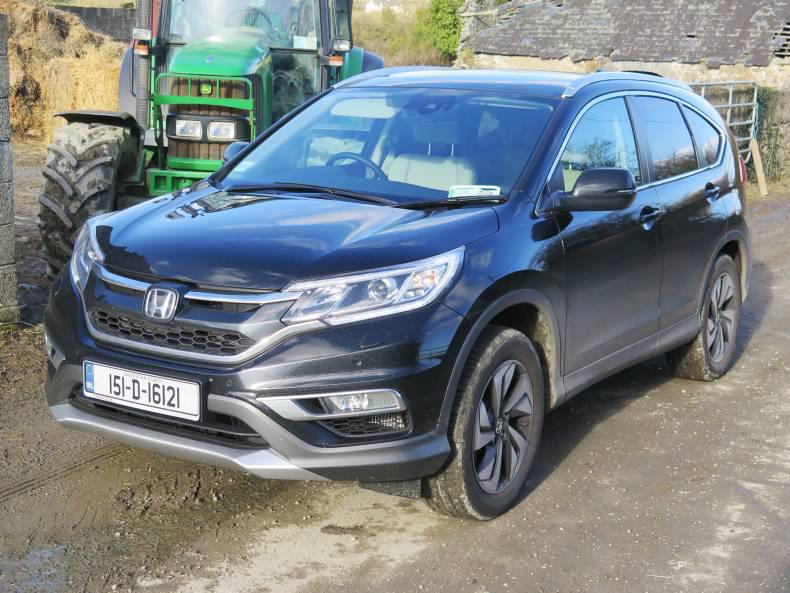Honda has boosted the 1.6-litre diesel engine for the new generation CR-V to give it the capacity to power an all-wheel-drive version of the SUV. The aim was to deliver more economy than before, when the all-wheel-drive versions could only be powered by a 2.2-litre engine.
After a week and 1,150km of driving, I was impressed with the new CR-V. The new engine gives a 15% improvement in fuel economy compared with the last engine, which is achieved through a twin turbo-charging system and the fact that the SUV is lighter.
There are minor styling differences in the new CR-V, including a change to the headlights and bumper redesign with extra chrome. But the overall look remains unchanged.
On the inside, the big change is the new Honda Connect touch-screen information system that comes with satellite navigation from the ES Sport specification upwards. It has a large screen and I found it easy to navigate and clear to use – it’s almost like a tablet. It provides a superb reversing camera as part of the package. All of the other controls were unchanged from the previous model.
The Honda CR-V is a spacious SUV, with good legroom and headroom, front and back. There is a spacious and stylish feel to the interior that’s now enhanced by a higher specification on almost all models, including Bluetooth as standard.
The boot is big and easily loaded. I love the Honda seat folding system that’s a dream to use, even for heavy seats. The rear section folds flat for long-load carrying.
Honda has boosted the power of this 1.6-litre engine to 160bhp, which is a 6% increase over the bigger engine of the past.
It has impressive 350Nm of torque – a measure of its pulling power. This helps the CR-V to accelerate from zero to 100km/hr in just 9.6 seconds, making it one of the fastest SUVs in its class.
Others are also offering 1.6-litre diesels and I looked at the Nissan X-Trail as a comparison. The Honda CR-V is marginally more powerful and beats the Nissan on economy, with matching 2,000kg trailer-towing capacity.
I put the economy of the engine to the test. Over a range of driving conditions where I pushed the CR-V to its legal limit, I returned an average figure of 14.5km/litre, compared with the manufacturer’s rating of 20.4km/litre. While I drove conscious of the need to keep the engine as close to the 2,000rpm rating as possible, varying road and field conditions took its toll on my economy efforts. Overall, I would consider the CR-V to be very economical, but I would prefer a bigger fuel tank.
The other benefits of this new engine include lower CO2 levels and road tax running costs with a €270 annual charge.
The twin-turbo system is a key part of the engine. Honda claims that the two-stage turbo feeds from two exhaust gas inlets – one is activated at low pressure (low engine speeds) and the other at high pressure (high engine speeds). The safety package on the CR-V includes Honda’s City Brake Active System which is designed to prevent low-speed accidents for town driving. It automatically engages the brakes at speeds lower than 32km/hr and gives the driver a warning first.
There is a host of other safety extras available. Some were fitted to the test car, but many are on the options list. I liked the new seatbelt system that goes with your body size and tucks you when you put it on. It also gives a slight tug of comfort on sharp turns. What’s important to note is that the CR-V’s current Euro NCAP five-star rating remains intact.
The entry price for the AWD version of the Honda CR-V is €37,495 (NI £27,570). This is €3,580 less than the price of the 2.2-litre engine on the previous entry model AWD version. With extra specification, this brings the CR-V into the value line, when including its good resale value.
Honda CR-V
Engine 1.6-litre diesel
Engine power 160bhp
0-100km/hr 9.6 seconds
Economy 20.4km/litre
Fuel tank capacity 58 litres
CO2 emissions 129g/km
Road tax band B1 (€270)
Main service 20,000km
Euro NCAP rating Five star (2013)
Towing rating 2,000kg
Warranty Seven years
Entry price €37,495
NI price £27,570






 This is a subscriber-only article
This is a subscriber-only article

















SHARING OPTIONS: